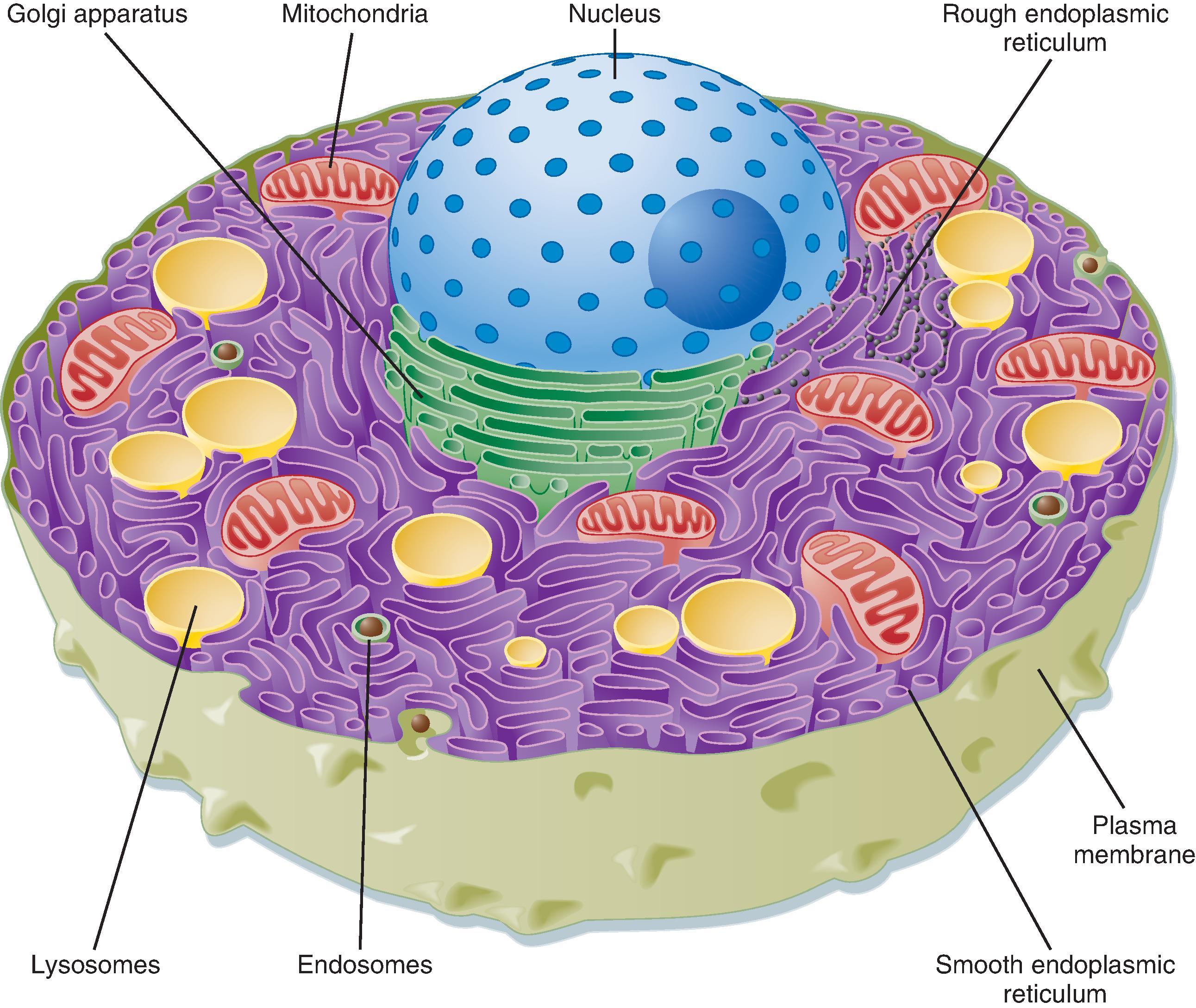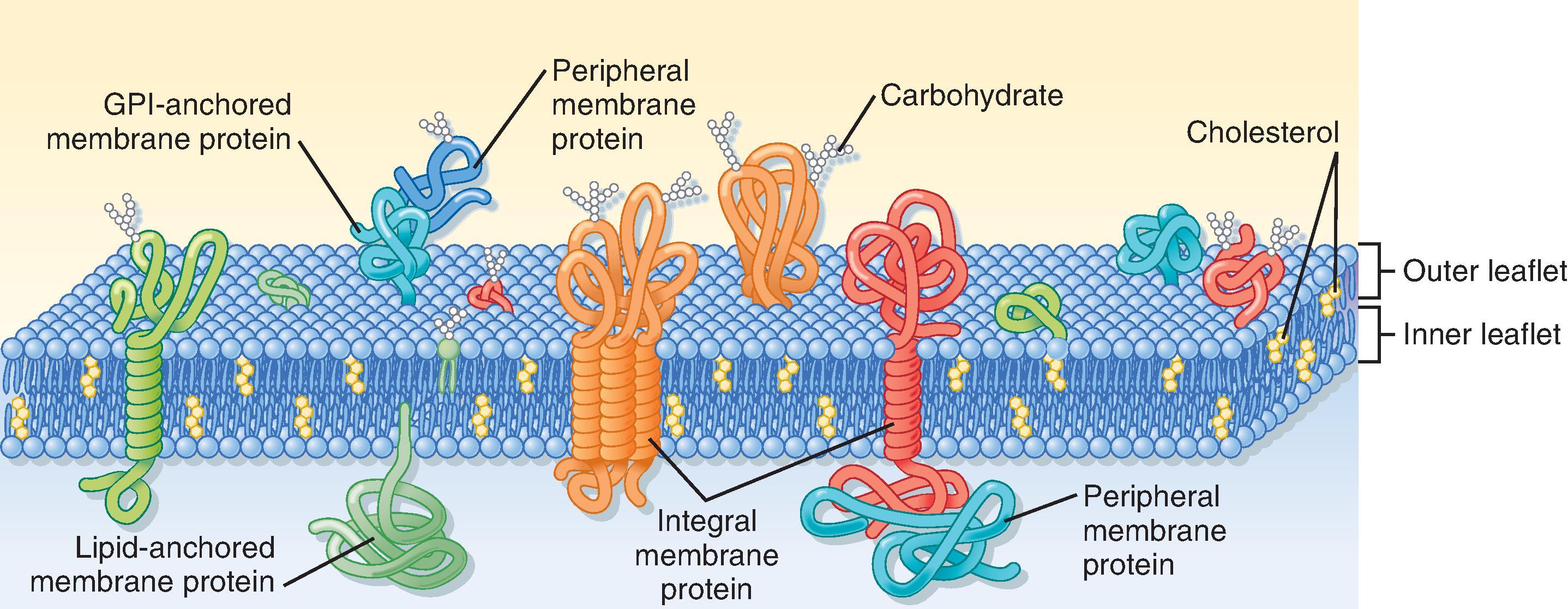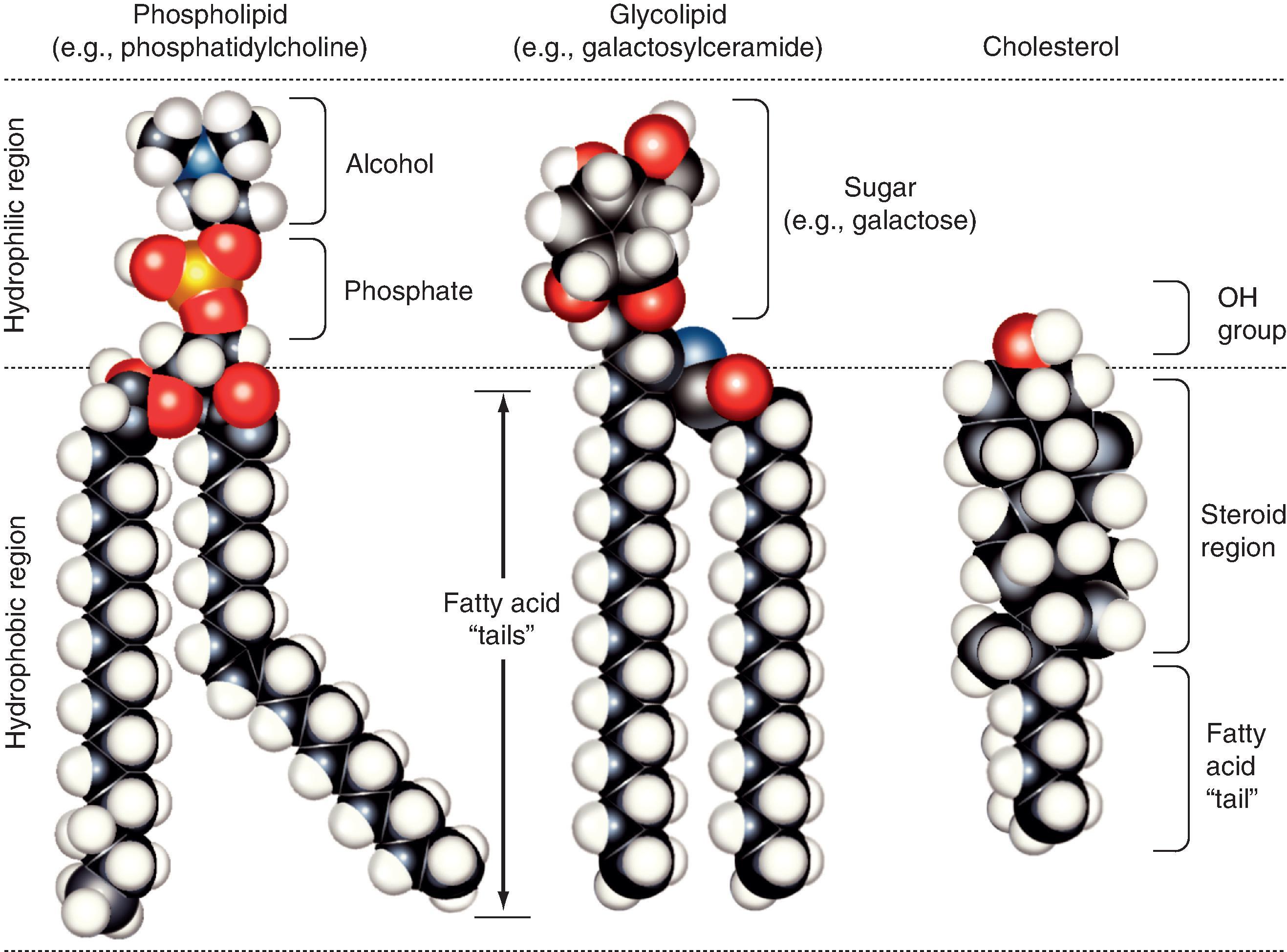Physical Address
304 North Cardinal St.
Dorchester Center, MA 02124
Upon completion of this chapter, the student should be able to answer the following questions:
What organelles are found in a typical eukaryotic cell, and what is their function?
What is the composition of the plasma membrane?
What are the major classes of membrane transport proteins, and how do they transport biologically important molecules and ions across the plasma membrane?
What is the electrochemical gradient, and how is it used to determine whether the transport of a molecule or an ion across the plasma membrane is active or passive?
What are the driving forces for movement of water across cell membrane and the capillary wall?
In addition, the student should be able to define and understand the following properties of physiologically important solutions and fluids:
Molarity and equivalence
Osmotic pressure
Osmolarity and osmolality
Oncotic pressure
Tonicity
The human body is composed of billions of cells. Although cells can perform different functions, they share certain common elements. This chapter provides an overview of some of these common elements with a focus on the transport of molecules and water into and out of the cell across its plasma membrane.
Eukaryotic cells are distinguished from prokaryotic cells by the presence of a membrane-delimited nucleus. With a few exceptions (e.g., mature human red blood cells and cells within the lens of the eye), all cells within the human body contain a nucleus. The cell is therefore effectively divided into two compartments: the nucleus and the cytoplasm. The cytoplasm is an aqueous solution containing numerous organic molecules, ions, cytoskeletal elements, and a number of organelles. Many of the organelles are membrane-enclosed compartments that carry out specific cellular function. An idealized eukaryotic cell is depicted in Fig. 1.1 , and the primary functions of some components and compartments of the cell are summarized in Table 1.1 . Readers who desire a more in-depth presentation of this material are encouraged to consult one of the many textbooks on cell and molecular biology that are currently available.

| Component | Primary Function |
|---|---|
| Cytosol | Metabolism, protein synthesis (free ribosomes) |
| Cytoskeleton | Cell shape and movement, intracellular transport |
| Nucleus | Genome (22 autosomes and 2 sex chromosomes—in humans), DNA and RNA synthesis |
| Mitochondria | ATP synthesis by oxidative phosphorylation, Ca 2+ storage |
| Smooth endoplasmic reticulum | Synthesis of lipids, Ca 2+ storage |
| Free ribosomes | Translation of mRNA into cytosolic proteins |
| Rough endoplasmic reticulum | Translation of mRNA into membrane-associated proteins or for secretion out of the cell |
| Lysosome | Intracellular degradation |
| Endosome | Cellular uptake of cholesterol, removal of receptors from the plasma membrane, uptake of small molecules and water into the cell, internalization of large particles (e.g., bacteria, cell debris) |
| Golgi apparatus | Modification, sorting, and packaging of proteins and lipids for delivery to other organelles within the cell or for secretion out of the cell |
| Proteosome | Degradation of intracellular proteins |
| Peroxisome | Detoxification of substances |
The cells within the body are surrounded by a plasma membrane that separates the intracellular contents from the extracellular environment. Because of the properties of this membrane and, in particular, the presence of specific membrane proteins, the plasma membrane is involved in a number of important cellular functions, including the following:
Selective transport of molecules into and out of the cell. A function carried out by membrane transport proteins.
Cell recognition through the use of cell surface antigens.
Cell communication through neurotransmitter and hormone receptors and through signal transduction pathways.
Tissue organization, such as temporary and permanent cell junctions, and interaction with the extracellular matrix, with the use of a variety of cell adhesion molecules.
Membrane-dependent enzymatic activity.
Determination of cell shape by linkage of the cytoskeleton to the plasma membrane.
In this chapter, the structure and function of the plasma membrane of eukaryotic cells are considered. More specifically, the chapter focuses on the transport of molecules and water across the plasma membrane. Only the principles of membrane transport are presented here. Additional details that relate to specific cells are presented in the various sections and chapters of this book.
The plasma membrane of eukaryotic cells consists of a 5-nm-thick lipid bilayer with associated proteins ( Fig. 1.2 ). Some of the membrane-associated proteins are integrated into the lipid bilayer; others are more loosely attached to the inner or outer surfaces of the membrane, often by binding to the integral membrane proteins.

The major lipids of the plasma membrane are phospholipids and phosphoglycerides. Phospholipids are amphipathic molecules that contain a charged (or polar) hydrophilic head and two (nonpolar) hydrophobic fatty acyl chains ( Fig. 1.3 ). The amphipathic nature of the phospholipid molecule is critical for the formation of the bilayer: The hydrophobic fatty acyl chains form the core of the bilayer, and the polar head groups are exposed on the surface.

The majority of membrane phospholipids have a glycerol “backbone” to which are attached the fatty acyl chains, and an alcohol is linked to glycerol via a phosphate group. The common alcohols are choline, ethanolamine, serine, inositol, and glycerol. Another important phospholipid, sphingomyelin, has the amino alcohol sphingosine as its “backbone” instead of glycerol. Table 1.2 lists these common phospholipids. The fatty acyl chains are usually 14 to 20 carbons in length and may be saturated or unsaturated (i.e., contain one or more double bonds).
| Phospholipid | Primary Location in Membrane |
|---|---|
| Phosphatidylcholine | Outer leaflet |
| Sphingomyelin | Outer leaflet |
| Phosphatidylethanolamine | Inner leaflet |
| Phosphatidylserine | Inner leaflet |
| Phosphatidylinositol * | Inner leaflet |
The phospholipid composition of the membrane varies among different cell types and even between the bilayer leaflets. For example, in the erythrocyte plasma membrane, phosphatidylcholine and sphingomyelin are found predominantly in the outer leaflet of the membrane, whereas phosphatidylethanolamine, phosphatidylserine, and phosphatidylinositol are found in the inner leaflet. As described in detail in Chapter 3 , phosphatidylinositol plays an important role in signal transduction, and its location in the inner leaflet of the membrane facilitates this signaling role.
The sterol molecule cholesterol is also a critical component of the bilayer (see Fig. 1.3 ). It is found in both leaflets and serves to stabilize the membrane at normal body temperature (37°C). As much as 50% of the lipids found in the membrane can be cholesterol. A minor lipid component of the plasma membrane is glycolipids. These lipids, as their name indicates, consist of two fatty acyl chains linked to polar head groups that consist of carbohydrates (see Fig. 1.3 ). As discussed in the section on Membrane Proteins, one glycolipid, glycosylphosphatidylinositol (GPI), plays an important role in anchoring proteins to the outer leaflet of the membrane. Both cholesterol and glycolipids, like the phospholipids, are amphipathic, and they are oriented with their polar groups on the outer surface of the leaflet in which they are located. Their hydrophobic portion is thus located within the interior of the bilayer.
The lipid bilayer is not a static structure. The lipids and associated proteins can diffuse within the plane of the membrane. The fluidity of the membrane is determined by temperature and by its lipid composition. As temperature increases, the fluidity of the membrane increases. The presence of unsaturated fatty acyl chains in the phospholipids and glycolipids also increases membrane fluidity. If a fatty acyl chain is unsaturated, the presence of a double bond introduces a “kink” in the molecule (see Fig. 1.3 ). This kink prevents the molecule from associating closely with surrounding lipids, and, as a result, membrane fluidity is increased. Although the lipid bilayer is “fluid,” movement of proteins in the membrane can be constrained or limited. For example, membrane proteins can be anchored to components of the intracellular cytoskeleton, which limits their movement. Membrane domains can also be isolated from one another. An important example of this can be found in epithelial tissues. Junctional complexes (e.g., tight junctions) separate the plasma membrane of epithelial cells into two domains: apical and basolateral (see Chapter 2 ). The targeted localization of membrane proteins into one or other of these domains allows epithelial cells to carry out vectorial transport of substances from one side of the epithelium to the opposite side. The ability to carry out vectorial transport is crucial for the functioning of several organ systems (e.g., the gastrointestinal tract and kidneys). In addition, some regions of the membrane contain lipids (e.g., sphingomyelin and cholesterol) that aggregate into what are called lipid rafts. These lipid rafts often have an association with specific proteins, which diffuse in the plane of the membrane as a discrete unit. Lipid rafts appear to serve a number of functions. One important function of these rafts is to segregate signaling molecules.
As much as 50% of the plasma membrane is composed of proteins. These membrane proteins are classified as integral, lipid-anchored, or peripheral.
Integral membrane proteins are imbedded in the lipid bilayer, where hydrophobic amino acid residues are associated with the hydrophobic fatty acyl chains of the membrane lipids. Many integral membrane proteins span the bilayer; such proteins are termed transmembrane proteins. Transmembrane proteins have both hydrophobic and hydrophilic regions. The hydrophobic region, often in the form of an α helix, spans the membrane. Hydrophilic amino acid residues are then exposed to the aqueous environment on either side of the membrane. Transmembrane proteins may pass through the membrane multiple times.
There is a superfamily of membrane proteins that serve as receptors for many hormones, neurotransmitters, and numerous drugs. These receptors are coupled to heterotrimeric G proteins and are termed G protein–coupled receptors (see Chapter 3). These proteins span the membrane with seven α-helical domains. The binding site of each ligand is either on the extracellular portion of the protein (large ligands) or in the membrane-spanning portion (small ligands), whereas the cytoplasmic portion binds to the G protein. This superfamily of membrane proteins makes up the third largest family of genes in humans. Nearly half of all nonantibiotic prescription drugs are targeted toward G protein–coupled receptors.
A protein can also be attached to the membrane via lipid anchors. The protein is covalently attached to a lipid molecule, which is then embedded in one leaflet of the bilayer. GPI anchors proteins to the outer leaflet of the membrane. Proteins can be attached to the inner leaflet via their amino-terminus by fatty acids (e.g., myristate or palmitate) or via their carboxyl-terminus by prenyl anchors (e.g., farnesyl or geranylgeranyl).
Peripheral proteins may be associated with the polar head groups of the membrane lipids, but they more commonly bind to integral or lipid-anchored proteins.
In many cells, some of the outer leaflet lipids, as well as many of the proteins exposed on the outer surface of the membrane, are glycosylated (i.e., have short chains of sugars, called oligosaccharides, attached to them). These glycolipids and glycoproteins are components of the “cell coat” called the glycocalyx. The glycocalyx establishes an extracellular microenvironment at the surface of the cell membrane. Depending on the cell, the glycocalyx may be involved in metabolism (e.g., in the gastrointestinal tract), cell recognition (e.g., cell surface antigens), and formation of cell-cell interactions (e.g., attachment of neutrophils to vascular endothelial cells).
Although plasma membrane proteins perform many important cellular functions, as noted previously, the remainder of this chapter focuses on one group of plasma membrane proteins: the membrane transport proteins, or transporters. It has been estimated that approximately 10% of human genes (≈2000) code for transporters. They are also targets for numerous drugs.
The normal function of cells requires the continuous movement of water and solutes into and out of the cell. The intracellular and extracellular fluids are composed primarily of H 2 O, in which solutes (e.g., ions, glucose, amino acids) are dissolved. The plasma membrane, with its hydrophobic core, is an effective barrier to the movement of virtually all of these biologically important solutes. It also restricts the movement of water across the membrane. The presence of specific membrane transporters in the membrane is responsible for the movement of these solutes and water across the membrane.
Become a Clinical Tree membership for Full access and enjoy Unlimited articles
If you are a member. Log in here